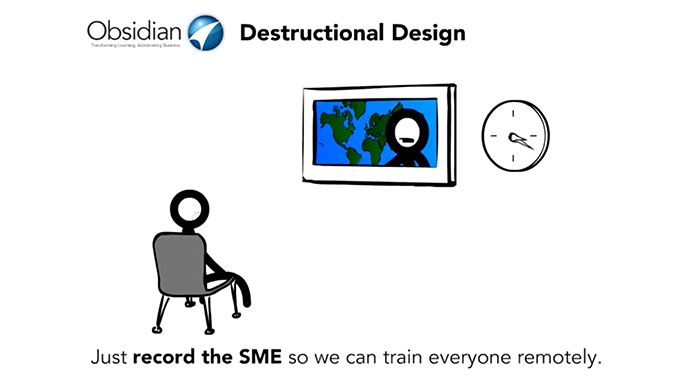Virtual learning includes any form of learning that occurs with the assistance of computer technology. Although in this context we often think of virtual classrooms with a live instructor teaching somewhere at a distance, virtual learning is much more than that. It is synonymous with eLearning.
Virtual Learning Is So Much More Than VILT
As a business leader, you may have heard the term a “VUCA world”. It is a strategic leadership term borrowed from the military referring to the ever-increasing volatility, uncertainty, complexity, and ambiguity of our global environment. The COVID-19 global pandemic is a prime example of a VUCA event. Such unpredictable elements in our business environments challenge all aspects of leadership but present some unique challenges in the areas of employee learning and development. Learning leaders (training managers, human resource managers, organizational development managers, and talent development/succession planning managers) now more than ever need flexibility to reach, engage, develop, and retain employees—all remotely. Virtual learning is a practical solution for these learning and development challenges even when working at a distance. It is economically feasible, and with the right skill set and technology, relatively easy to design, develop, and implement.
There are still some common misconceptions about virtual learning, though—what it is and what it isn’t, when it can and cannot be effective—that are worth unpacking in this first article in our series about virtual learning.
Let’s start by defining virtual learning to create a shared understanding. Virtual learning is really any learning that happens at a distance; that is, remotely. Content is delivered via online technology to groups or individuals in their own environments. At its core, virtual learning is synonymous with eLearning. So whether your employees are now working from home because of a VUCA event or your organization has simply reduced or eliminated travel, virtual learning is a must in all organizations.

Myth 1: Virtual Learning = Virtual Instructor-Led Training (VILT)
When thinking of virtual learning, many people focus only of the subset of virtual learning known as virtual instructor-led training (VILT). In VILT, there is typically a live instructor delivering content via remote presentation. This is most often achieved through video conferencing technology and is frequently designed to simulate a traditional classroom experience. In the early days of the pandemic, many academic institutions took this approach. Because it is often relatively fast to convert a traditional instructor-led course to a virtual one, this type of virtual learning certainly has its place in the arsenal of employee development, but there are often more effective and engaging remote delivery options. Besides VILT, virtual learning may consist of online simulations, interactive web-based courses, collaborative forums, self-paced mobile learning, gamified content, performance support tools, and reference-based learning to name a few. In fact, virtual learning has the most impact and can reach the widest range of learners with a blended approach that includes many different types of delivery to keep it fresh for the learner.

Myth 2: Virtual Learning Is Boring and Unengaging
If your virtual learning experience has been limited to tedious annual compliance courses or at-home defensive driving, you may assume that all virtual training is boring. This just isn’t true! Virtual learning can be immersive, compelling, impactful, and even fun. Learning leaders need to invest in virtual learning experiences that are engaging and effective. The payoff is high—meeting your learning objectives and increasing employee engagement and retention. Keeping employees satisfied and engaged is definitely more of a challenge when working remotely. Learning and development needs should be seen as opportunities to further engage and support your remote workforce. Check out our article How to Adapt Your Microcontent to Your Employees’ Social Needs to learn more. (Even if your workforce is not remote, virtual learning still has tremendous advantages in reducing travel time and cost, allowing learners to self-pace and more independently manage their time.)
So how do you develop stimulating, engaging virtual learning instead of dull page-turners? This is where design expertise comes into play. (Be on the lookout for our upcoming article on innovative virtual learning design tips.)

Myth 3: Engaging Virtual Learning Is Too Expensive to Create
So maybe you are on board with respect to highly engaging virtual learning, but you feel like developing such training is just too expensive. Good news! With today’s rapid course development tools and great inexpensive or even free resources, you can develop virtual learning that includes videos, attention-grabbing graphics, and even basic animation. The secret is all in the thoughtful and learner-targeted design. It is true that if you need Pixar-studio level animation or production-company quality dramatic video, virtual learning can become quite costly to develop. Fortunately, today’s learners are often perfectly happy with YouTube-level instructional videos. With a good phone camera and maybe a tripod, your team can create simple, utilitarian videos to include in your virtual learning strategy. There are also several affordable animation tools that can help a non-programmer jazz up their virtual learning. Just as you would expect in an instructor-led course, virtual learners need regular interaction and engagement. As a training department manager, be sure to look for specific design skills and resources when evaluating vendors or potential team members. (See our article 10 Questions to Consider when Selecting a Custom eLearning Content Provider for tips on vendor evaluation.)

Myth 4: Virtual Learning Is Ineffective for What I Need to Teach
For instructors who have long depended on being in front of a classroom, converting to a virtual approach can seem impossible. How can you respond to your learners’ changing needs as the lesson progresses? How can you convey highly technical or complicated information remotely? How can you provide timely feedback as learners practice specific skills? This is where a careful analysis of the learning objectives and possible technologies come into play. It can be most helpful for training and OD managers or small business owners to consult with an expert in virtual learning to get ideas for how to use the technologies available to achieve the specific learning objectives. There are so many new tools and technology platforms that support virtual learning! The content and objectives might require a virtual instructor-led learning environment where students watch the facilitator perform tasks live. Or the subject matter might lend itself better to a combination of videos and self-paced practice. There is very often a way to break down even the most complex task or subject into microlearning nuggets that learners can access and master at their own pace. Feedback can be provided in many creative ways. You can establish a forum or learning community where learners can collaborate and communicate with an expert, or perhaps most of the learning can be self-paced with accompanying skills demonstrations provided by video conference. Again, a blended approach is often best as it allows you to maximize the key benefits of various methods.

Myth 5: Virtual Learning Is Impersonal and Non-Collaborative
Remember that virtual learning is synonymous with online learning, so it can take many forms, including collaborative social learning like a team online project. Tools as simple as Google Docs can be used to develop highly collaborative virtual learning experience. Traditional eLearning has the twin advantages of consistency and repeatability. (Think about a course on safety that must teach a very standard procedure to its audience.) An effective virtual learning strategy will also weave in highly personal elements. Perhaps after taking safety training, learners reflect and post their own reasons for adopting the safety guidelines in a discussion group. We know that the best learning is anchored in emotion and that can certainly be achieved in a virtual learning environment. Again, targeted, learner-centric design is essential.

Truth 1: Virtual Learning Is Difficult to Update/Maintain
Compared to instructor-led training, it’s true that changing and editing virtual learning can take more effort. If you have content that is constantly evolving, your team will definitely want to factor that into your virtual learning strategy. Save video and animation for those items least likely to require updating and use other media for more fluid content. Is there a way you can direct learners to primary sources that are updated regularly rather than including that content directly in your course? For example, in an onboarding program, direct learners to the online company organizational chart rather than provide one in your course. Also consider making your virtual training applicable to a general audience. Can you take your virtual learning global by using more universal terminology? Or by providing location-specific information in the supplemental materials? Also remember that an effective virtual learning strategy includes regular review of all elements to check for needed updates. Although more effort to update, the payoff comes when you can, for example, roll out your changes globally simply by updating the course source files in your LMS.

TRUTH 2: The Success of Virtual Learning Depends on Your Technology
While virtual learning can be accomplished using a wide spectrum of technologies, it is true that a fundamental access to those technologies is required. As many school districts across the country discovered when rushing to convert to an online format during the early days of the COVID-19 pandemic, not everyone has access to the internet and appropriate devices for learning at home. When rolling out an online course for a global client, we had to develop a contingency plan for their Angola office which did not have consistent high-speed internet access. Your development and deployment strategy must take such limitations into account. With a little strategic thinking, however, you can achieve virtual learning under most circumstances.

Truth 3: It Gets Better With Experience
As online learning tools continue to improve and become easier to use, virtual training gets easier to develop and deploy. That doesn’t mean it necessarily sparks effective learning. Virtual learning still requires thoughtful and strategic consideration of your audience and learning objectives, engaging and impactful design, and careful evaluation of results. Perhaps the most common mistake is overloading your learners with too much content. Even when learning is self-paced and engaging, a learner can only take in so much new information. The good news is that over time, you can really hone and improve your virtual learning by continuously evaluating learner performance, and soliciting input from learners, their colleagues, and managers. As learners, designers, and (as applicable) facilitators adjust to new remote technologies, the virtual learning experience improves.
Conclusion
So as our world experiences volatile and complex events like the COVID pandemic, we need flexible ways to communicate with and develop a remote workforce. Virtual learning can comprise many modalities and levels of engagement—so much more than just VILT. Virtual learning is practical, affordable, and effective, helping learners in very personal and individual ways, but it does require strategy and intention in its application. Keep an eye out for our continuing series on this topic, which will provide additional insights, useful tips, and concrete strategies for developing high impact virtual learning programs.








